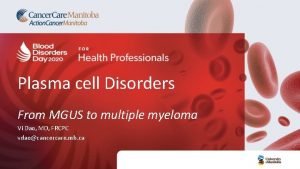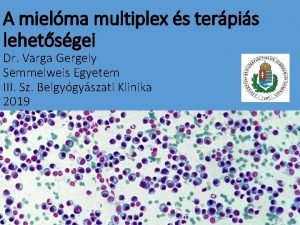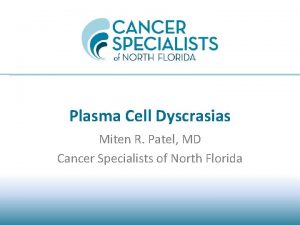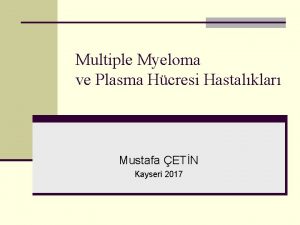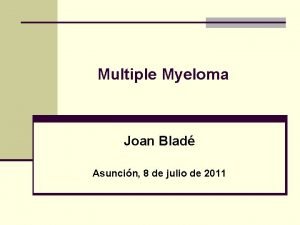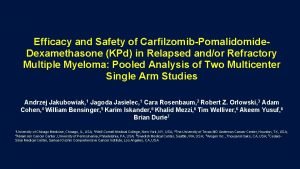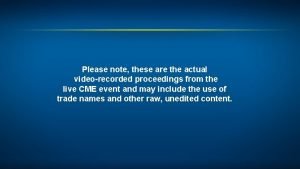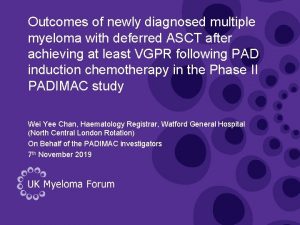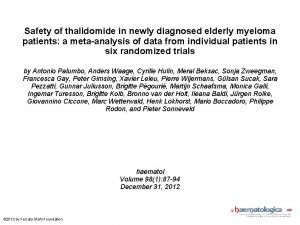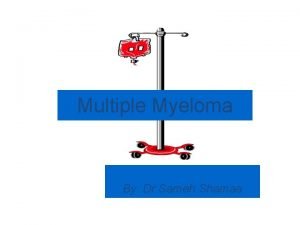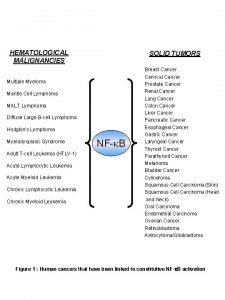Second Primary Malignancies in Newly Diagnosed Multiple Myeloma









- Slides: 9

Second Primary Malignancies in Newly Diagnosed Multiple Myeloma Patients Treated with Lenalidomide: Analysis of Pooled Data in 2459 Patients Palumbo A et al. Proc ASH 2011; Abstract 996.

Background The observation of an 8 -fold increased incidence of AML/MDS in MGUS (monoclonal gammopathy of undetermined significance) compared to that of the general population supports a role of nontreatment-related factors in the development of AML/MDS in plasma cell dyscrasias (Blood 2011: 118, 4086). l l In patients with multiple myeloma (MM), the risk of second primary malignancy (SPM) is influenced by age and the use of alkylating agents. Current study objective: – Post hoc analysis to assess the risk of development of SPMs in patients with newly diagnosed MM who were enrolled in 9 studies of the European Myeloma Network Palumbo A et al. Proc ASH 2011; Abstract 996.

Study Method l SPM incidence rates per 100 person-years were examined from 9 trials: RVMM EMN 01; RVMMEMN 441; RVMM PI 026; RVMM PI 302; RVMM PI 209; GIMEMA MM 03 05, GIMEMA MM 04 05, GISMM 2001; HOVON 87. l Treatment received in the examined trials: – Cyclophosphamide-lenalidomide-corticosteroids (CRC), n = 326 – Melphalan-prednisone-lenalidomide (MPR), n = 668 – Autologous stem cell transplant followed by lenalidomide maintenance (ASCT-R), n = 484 – Melphalan-prednisone (MP), n = 164 – MP-thalidomide (MPT), n = 384 – MP-bortezomib (VMP), n = 257 – MPV-thalidomide (VMPT), n = 254 – Lenalidomide-low-dose dexamethasone (Rd), n = 147 Palumbo A et al. Proc ASH 2011; Abstract 996.

Incidence of SPMs per 100 per year* Median follow-up (mo) Incidence (%) All patients (n = 2, 283) 29. 1 0. 87 Dex/cyclo-lenalidomide (n = 351) 17. 1 0. 4 Melphalan-lenalidomide (n = 972) 30. 0 0. 95 Melphalan-thalidomide (n = 539) 35. 9 1. 05 Melphalan no IMi. Ds (n = 421) 40. 6 0. 42 Treatment received Dex = dexamethasone; Cyclo = cyclophosphamide * Post hoc analysis was restricted to pooled data from 2, 283 patients with at least 1 year of follow-up. Palumbo A et al. Proc ASH 2011; Abstract 996.

SPM Cases SPMs (%) Treatment received Total Solid tumors Hematologic cancer All patients (n = 2, 283) 2. 1 1. 7 0. 4 Dex/cyclo-lenalidomide (n = 351) 0. 6 0. 0 Melphalan-lenalidomide (n = 972) 2. 4 2. 2 0. 2 Melphalan-thalidomide (n = 539) 3. 1 1. 8 1. 3 Melphalan no IMi. Ds (n = 421) 1. 4 1. 2 0. 2 Dex = dexamethasone; Cyclo = cyclophosphamide Post hoc analysis was restricted to pooled data from 2, 283 patients with at least 1 year of follow-up. Palumbo A et al. Proc ASH 2011; Abstract 996.

Incidence of SPMs per 100 per Year Subgroup Analysis According to Therapy SPMs = second primary malignancies; Dex = dexamethasone; Cyclo = cyclophosphamide With permission, Palumbo A et al. Proc ASH 2011; Abstract 996.

SPMs and Risk of Death Dex/cyclo - Lenalidomine Melphalan - Thalidomide Melphalan - Lenalidomine Melphalan - no IMi. Ds Death Solid SPMs Hematologic SPMs Months Risk of death is greater than the risk of SPMs With permission, Palumbo A et al. Proc ASH 2011; Abstract 996.

Author Conclusions l With a short follow-up time as a study limitation, the data currently support a role for nontreatment-related factors as causes of SPMs. l SPM incidence was lower than expected in all treatment groups, and the observed and expected rates of SPMs were similar (data not shown). l The benefits of continuous therapy with lenalidomide outweigh the potential risk of SPMs: – The risk of death is greater than the risk of SPM. l Longer follow-up is needed to assess the risks of SPMs in patients receiving lenalidomide with alkylating agents. Palumbo A et al. Proc ASH 2011; Abstract 996.

Investigator Commentary: Assessment of SPM Risk in MM This study from the European Myeloma Network clearly noted no reported cases of SPM in patients receiving cyclophosphamide and lenalidomide as a combination therapy. By contrast, melphalan, which is more genotoxic than cyclophosphamide, is associated with a small but observable rate of increased acute leukemia/MDS in particular. I am aware from my own practice, and from historical data with melphalan, that there is a real signal in terms of secondary leukemia from treatment with melphalan. In a number of trials in the relapsed setting, in which patients have been receiving lenalidomide-based therapy for prolonged periods of time — either lenalidomide alone or lenalidomide with dexamethasone — the signals for a secondary malignancy related to lenalidomide use have been minimal. Based on the data from the IFM 2005 -02 trial, I would say that the risk of SPM from maintenance lenalidomide after transplant is low, but if patients have not received much genotoxic therapy, they are much less likely to develop SPMs. Given the survival benefit now seen in the CALGB trial with the use of lenalidomide maintenance after SCT, these data must be kept very much in perspective, and certainly in our group the enthusiasm for continued therapy with lenalidomide in the appropriate clinical context remains high. Interview with Paul G Richardson, MD, January 24, 2012



